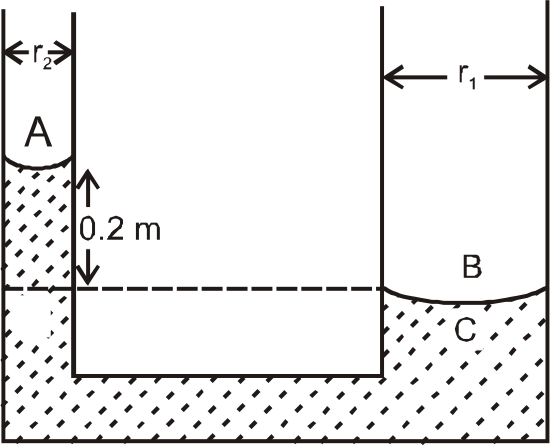A barometer contains two uniform capillries of radii 1.44×10−3m and 7.2×10−4m. If the height of the liquid in the narrow tube is 0.2m more than that in the wide tube, calculate the true pressure difference. Density of liquid =103kg/m3, surface tension =72×10−3N/m and g=m/s2.
Let the pressure in the wide and norrow capillaries of radii r1 and r2 respectively be P1 and P2.
Then pressure just below the meniscus in the wide and narrow tubes respectively are
(P1−2Tr1) and (P2−2Tr2) [excess pressure =2Tr]
Difference in these pressures =(P1−2Tr1)−(P2−2Tr2)=hρg
∴ True pressure difference =P1−P2
=2ρg+2T(1r1−1r2)
=0.2×103×9.8+2×72×10−3[11.44×10−3−17.2×10−4]
=1.86×103=1860N/m2
Topper's Solved these Questions
- SURFACE TENSIONBOOK - RESONANCECHAPTER - SURFACE TENSIONEXERCISE - Exercise- 1 PART - I
10 Videos
- SURFACE TENSIONBOOK - RESONANCECHAPTER - SURFACE TENSIONEXERCISE - Exercise- 1 PART - II
17 Videos
- STRING WAVESBOOK - RESONANCECHAPTER - STRING WAVESEXERCISE - Exercise
32 Videos
- UNITS, DIMENSION & MEASUREMENTBOOK - RESONANCECHAPTER - UNITS, DIMENSION & MEASUREMENTEXERCISE - Exercise
27 Videos
Similar Questions
A barometer contains two uniform capillaries of radii 1.4×10−3m and 7.2×10−4m. If the height of liquid in narrow tube is 0.2m more than that in wide tube, calculate the true pressure difference. Density of liqid =103kg/m3, surface tension =72×10−3N/m and g=9.8ms−12.
View SolutionThe limbs of a manometer consist of uniform capillary tubes of radii are 10−3&7.2×10−4m find out the correct pressure difference if the level of the liquid in narrower tube stands 0.2 m above that in the broader tube. (density of liquid =103kg/m3, surface tension =72×10−3N/m)
View Solution
Knowledge Check
Two seperate soap bubbles of radii 3×10−3 m and 2×10−3 m respectively, formed of same liquid (surface tension 6.5×10−2 N/m) come together to form a double bubble. The radius of interface of doubl bubble is
A6×10−3 mB4×10−3 mC1.5×10−3 mD0.66×10−3 mIf water rises in a capillary tube upto 3 cm . What is the diameter of capillary tube (Surface tension of water =7.2×10−2N/m)
A9.6×10−4mB9.6×10−3mC9.6×10−2mD9.6×10−1mAt a depth of 500 m in an ocean what is the absolute pressure? Given that the density of seawater is 1.03×103kgm−3 and g=10ms2
A40 atmB52 atmC32 atmD62 atm
The limbs of a manometer consists of uniform capillary tubes of radii 1.44×10−3m and 7.2×104m. If the level of the liquid in the narrower tube stands 0.2 m above that in the broader tube, pressure difference between A and B is found to be 310λN/m2. Here λ is an integer. Find λ (density = 103kg/m3, surface tension = 72×10−3N/m). (take g=9.8m/s2)

View SolutionA glass tube of 1 mm bore is dipped vertically into a container of mercury, with its lower end 5 cm below the mercury surface. What must be the gauge pressure of air in the tube to a hemispherical bubble at its lower end? Given density of mercury =13.6×103kg/m3, surface tension of mercury = 440×10−3Nm−1 and g=10m/s2
View SolutionTo what height does the liquid rise in a capillary tube of radus 0.25 mm, when dipped in a liquid of density 0.8×103kgm−3 and surface tension 0.05 N m−1? Given (cosθ=0.4)
View SolutionA liquid rises to a height of 7.0 cm in a capillary tube of radius 0.1 mm. The density of the liquid is 0.8×103kgm−3.If the angle of contact between the liquid and the surface of the tube zero , calculate the surface tension of the liquid Given g=10ms−2.
View SolutionThe pressure at a point in water is 10 N/m2. The depth below this point where the pressure becomes double is (Given density of water = 103 kg m−3, g = 10 m s−2)
View Solution